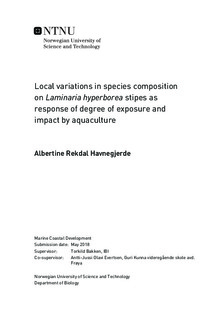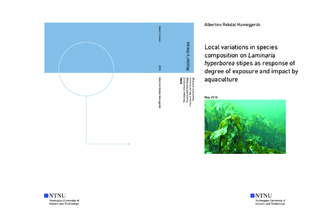| dc.description.abstract | Laminaria hyperborea kelp forest is a vitally important habitat that provides feeding ground, hiding space and habitat for numerous other species of both fauna and flora. Approximately 80 % of the total Norwegian algae biomass of 30 million tons is kelp forest build up by this species. L. hyperborea develops on hard-bottom substrates and covers in-between 5,000 to 10,000 km2 of the Norwegian coast. L. hyperborea is suitable for attachment of epigrowth, because of its rough and perennial stipe. Farming of Salmo salar in open net cages at sea has had a rapid increase in production size since the breakthrough in the late 1970s. Yearly production in Norway is over 1.2 million tons, which results in annually release of approximately 34,000 tons nitrogen and 9,750 tons phosphorus. The Norwegian Standard NS 9410 describes methods for risk based environmental monitoring of benthic impact in soft-sediment areas under the cages, while areas with hard-sediments around the fish farms or the dissolved nutrients in the water column are not under any form of monitoring.
L. hyperborea and its species composition from several locations have been examined to have a closer look at the possibility of creating a new indicator for impact by emissions from fish farming activity. The locations were either impacted or not by fish farming activity and positioned in an exposed or protected area. From each location both sampling rounds, ten individuals of L. hyperborea were collected. Age was determined for all ten individuals, along with measurements of total length and stipe length. Five individuals, the oldest, the youngest and three in-between were chosen to be examined for immobile fauna and flora. The results shows that there are a difference in the species composition between locations. In addition, a seasonal variation in the species composition and a difference in the number of attached taxa depending on the kelp individuals age were detected. It were also observed that the protected impacted locations lacked kelp. It can seem like the distance from the cages for the exposed impacted locations have had an effect on the species composition. The missing kelp can be an indicator of elevated levels of emissions from fish farming, based on the high aggregations of Echinus esculentus and Ophiocomina nigra. Based on the results it is recommended to preform further investigation to see if L. hyperborea and its attached fauna and flora can function as an indicator for elevated emission loads. The method applied for this project has several holes, and suggestions for improvements are to focus on certain species, sample at specific times, increase sample size and to use sample quadrates. In addition, a suggestion of using methods described in this project together with important element from NS 9410 is presented, as an adaptation of hard-bottom monitoring directly beneath and in surrounding areas near fish farm cages. | en |

